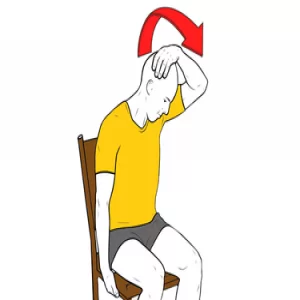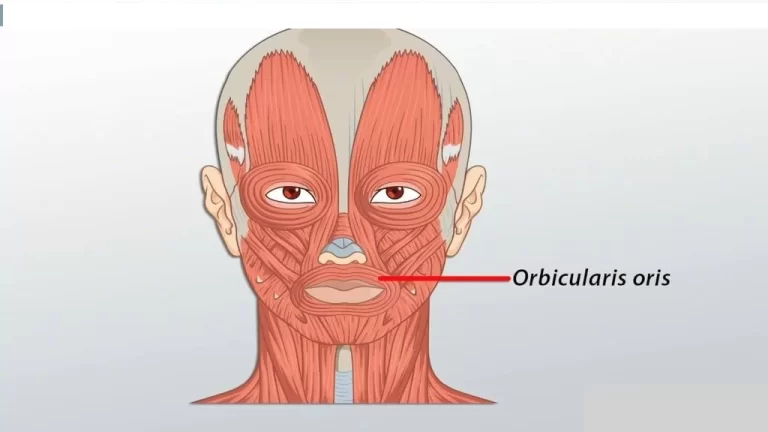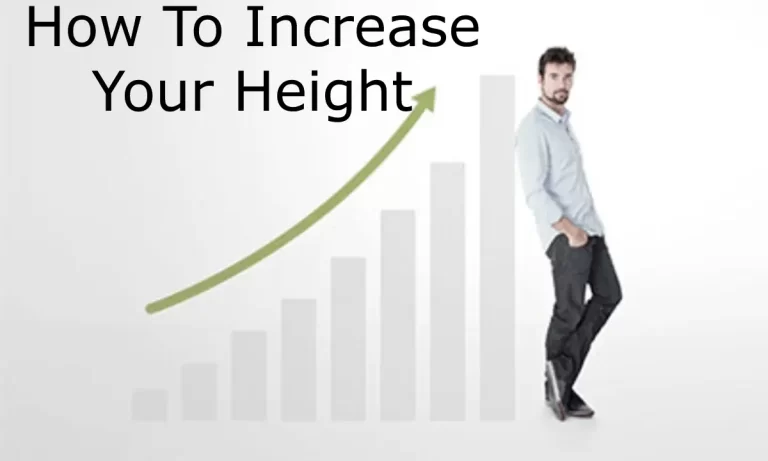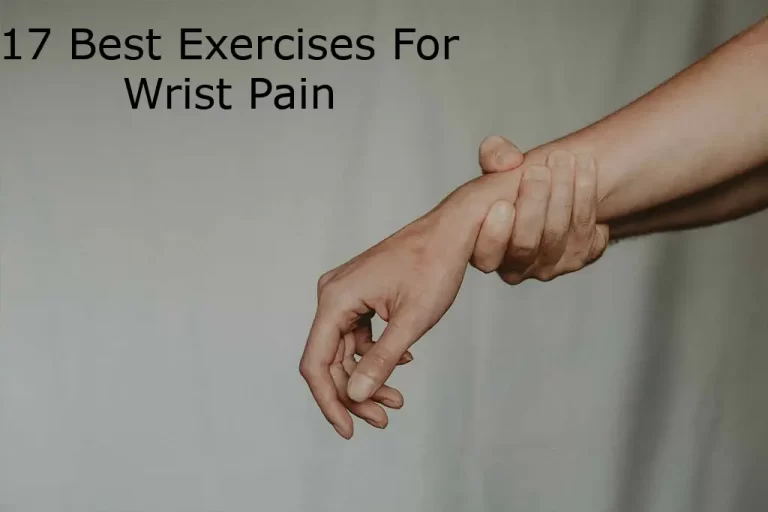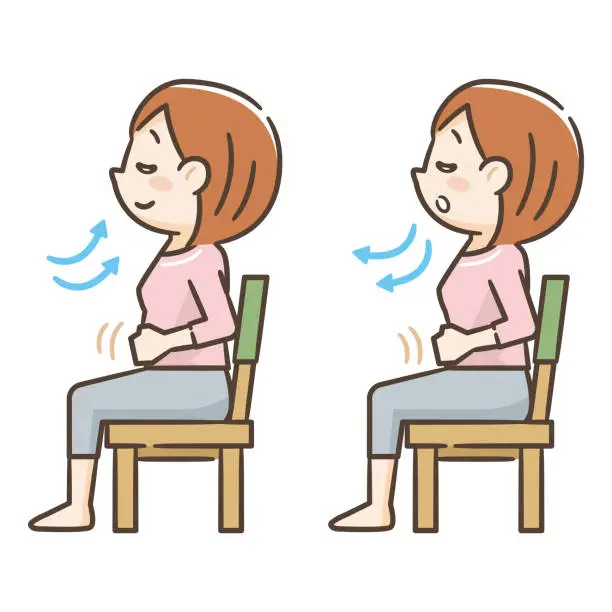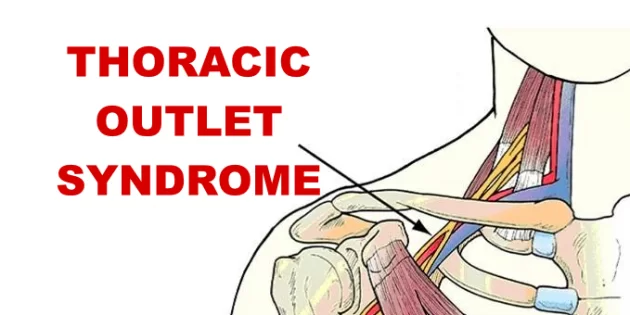25 Best Exercises to Fix Text Neck Pain
Introduction:
Exercises for Text Neck is an essential part of your overall treatment program along with Pain Medication, Physiotherapy Treatment and ergonomics.
Text neck is a term used to describe the neck pain that has become increasingly widespread as a result of our excessive usage of electronic devices technology. The strain on the neck from staring down at our phones and tablets for extended periods of Time is to blame. This strain can result in pain, stiffness, and even a restricted range of motion. And it’s growing more common in younger people because of the amount of time they spend on their smartphones.
Neck pain is fairly prevalent, and as physiotherapists, we will diagnose and design a therapy plan tailored to your specific presentation. Strengthening and stretching your muscles may help ease some of that nagging neck ache, according to research. Some persons with neck pain benefit from exercise therapy.
Stretches and exercises to improve the strength and flexibility of the neck.Better posture when using cellphones and other mobile devices. Exercise on a regular basis. A strong, flexible back and neck can withstand additional stress. Some research suggests that youth who participate in low-impact team sports or endurance sports are less likely to get neck pain.
Strengthening and stretching to target areas around your back, neck, and shoulders are among the physical therapy exercises for tech neck.
Exercise for text neck has the following benefits such as:
Here are some of the positive effects of frequent exercise sessions.
- Enhances daily exercise performance
- Improve your posture or your balance.
- Muscle Relaxation
- Reduce discomfort
- Improve your movement.
- Increase your adaptability.
- This allows it to build up muscles that are weak.
- Relax any tenseness or tightness.
- Exercise can help you regain mobility.
- Enhancing coordination.
- Improve your equilibrium.
The most beneficial text neck exercise is:
Following are the most effective training sessions for text neck:
Chin Tucks
- Begin by sitting or standing erect and concentrating your eyesight across the room on a single location.
- To help guide your actions, place your index finger on your chin.
- Gently move your head back in a totally horizontal motion, tucking your chin against your neck.
- The move should result in a double chin while keeping your gaze straight ahead, rather than your head bending down to look at your toes.
- Return to your neutral position after that.
- Then relax.
- Repeat 5-10 times a day.

Trapezius stretch
- Begin by sitting in a comfortable position.
- Putting your left hand on the head’s right side.
- Apply light pressure.
- Push your head down towards your shoulder.
- Hold the position for 20-30 seconds.
- After that, return to the Neutral position.
- Then relax.
- Switch to the other side.
- Repeat 5-10 times on each side.
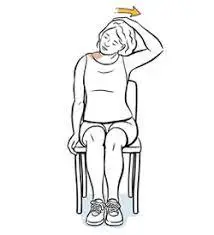
Thoracic extension
- Place both feet on the floor and sit in a chair.
- Raise your arms and position your hands behind your head, fingers interlaced.
- Lean forward in your chair, dropping your tummy towards your thighs while keeping your back straight.
- Raise your elbows while tilting your head to look up at the ceiling, keeping your stomach tight to your thighs and only your upper back curling.
- Hold for a couple of seconds.
- After that, return to the Neutral position.
- Then relax.
- Repeat 5-10 times a day.
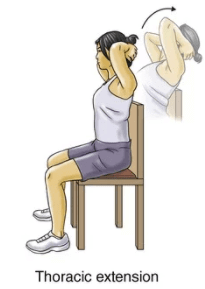
Prone scapula squeeze
- Begin by lying on your stomach on the bed.
- Place a tiny rolled cloth beneath your brow.
- Maintain your arms by your sides, palms facing in.
- Squeeze your shoulder blades together.
- You may feel the front of your shoulders lifting off the bed as you do this.
- Maintain this posture for a few seconds.
- Return to your neutral position after that.
- Then relax.
- Repeat 5-10 times.
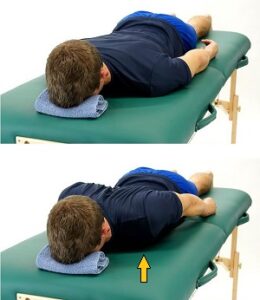
Shoulder Scapular Squeeze
- Keep your hands by your side while you sit or stand.
- To feel a stretch at the front of your chest, open your elbows to the side and squeeze your shoulder blades back.
- Pull your head and shoulders down and backward to enhance the stretch – continue to face forward and bring your shoulders back.
- Keep your hands away from your ears.
- Hold the posture for a few seconds.
- Return to a neutral state.
- Then relax.
- This should be done 5-10 times.

Exaggerated nod
- Begin by sitting comfortably at your workstation or standing with your shoulders relaxed.
- Look up towards the ceiling with your mouth closed, teeth touching but not clenched.
- Allow your jaw to relax and open your mouth here.
- Check to see if you can move your head back an inch or two (you should be able to).
- Keep your head motionless and close your mouth by bringing your lower jaw to your upper jaw.
- A stretch should be felt in the front of your neck.
- Return to a neutral state.
- Then relax.
- This should be done 5-10 times.

Downward-Facing Dog
- Start on all fours.
- Lift your hips high, stretching your hip bones towards the ceiling.
- Return your heels to the mat, but don’t let them plank on the ground.
- Drop your head and stretch your neck.
- Keep your wrist creases parallel to the front border of the mat as you stay here.
- Press into the knuckles of your forefingers and thumbs to relieve pressure on your wrists.
- Take at least three deep breaths here.
- Then let go.
- Return to a neutral state.
- Then relax.
- This should be done 5-10 times.
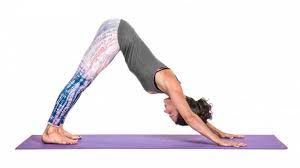
Neck roll
- Begin by sitting in a comfortable position.
- Move your gaze to the right.
- Until you feel a mild stretch in the muscles of your neck.
- Roll your head clockwise after a few seconds.
- When you reach your left shoulder side, hold for a few seconds.
- Again, you should feel a mild stretch in your neck muscles.
- Complete the clockwise revolution.
- Return to a neutral state.
- Then relax.
- This should be done 5-10 times.
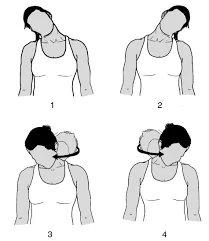
Cat-Cow
- Begin in the tabletop posture, with hands and knees on the ground.
- Maintain a straight back.
- Maintain your hands and feet on the ground.
- Inhale, then look up, allowing your tummy to fill with air.
- Maintain this posture for a few seconds.
- Exhale and bury your chin into your chest, arching your spine towards the ceiling.
- You notice a mild stretch in your lower back.
- Maintain this posture for a few seconds.
- Return to your neutral position after that.
- Then relax.
- 5-10 times through this exercise.
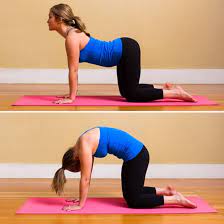
Toe Touch
- Place your feet hip-distance apart.
- Then, bend forward and let your arms rest on the floor.
- If it’s difficult, only extend your arms as far as you can without straining.
- Bend your knees and elevate your feet off the ground, palms up, to slip your hands underneath your feet.
- Allow your toes to enter the wrinkles of your wrists.
- Relax your head and press the balls of your feet against your hand.
- Take at least three deep breaths here.
- Return to a neutral state.
- Then relax.
- This should be done 5-10 times.

Bow pose
- Your hands should be by your sides as you lay flat on your stomach with your chin on the ground.
- As closely as you can, bring your heels to your buttocks while bending your knees.
- Grab hold of your outer ankles with both hands as you lean backward.
- Lifting your heels up towards the ceiling as you inhale will cause your upper body, thighs, and chest to rise off the mat.
- Try lifting your heels higher while maintaining your tailbone pressed into the mat to increase the stretch.
- Draw your shoulders away from your ears while focusing ahead.
- Ten breaths should be held in this position.
- Release by bringing your thighs first, then the rest of your body, to the ground as you exhale.
- Return to a neutral state.
- Then relax.
- This should be done 5-10 times.
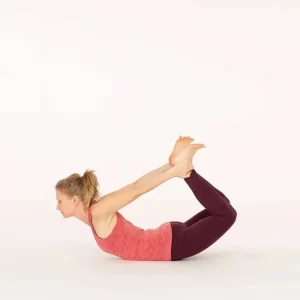
Quadruped Thoracic Rotation Stretch
- Start off on all fours, placing your hands and knees under your shoulders and your hips.
- Keep your back flat and tense your abdominals.
- Place your left hand behind your head with your elbow pointing out to the left.
- Don’t put any strain on your head or neck by resting your hand softly.
- This is the starting point.
- Rotate your head and shoulders slowly towards your right hand on the floor.
- Then, reverse the action by rotating to the left and up until your elbow is pointing towards the ceiling.
- Hold for a couple of seconds.
- Return to the starting point.
- Continue this movement for 30 seconds, and then switch sides.
- Return to a neutral state.
- Then relax.
- This should be done 5-10 times.
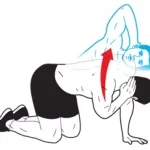
Bird Dog
- Begin by settling into the tabletop position while on all fours.
- Now lay your hands beneath your shoulders and your knees beneath your hips.
- Don’t tense up your spine.
- Put pressure on the shoulder blades.
- After that, extend your left leg and right arm.
- Keep your hips and shoulders in line with the ground.
- For a brief while, maintain this posture.
- Then go back to where you were.
- Lift your right leg and left arm.
- Retaining this stance for a short while.
- Go back to the beginning place.
- Do this exercise 5 to 10 times.
Reverse Shoulder Stretch
- Begin by standing tall with your fingers linked behind you towards your buttocks.
- Push your arms up until you feel a stretch in your pecs while keeping your back straight and shoulder blades together.
- Maintain for at least 30 seconds.
- Return to a condition of neutrality.
- Then relax.
- This should be repeated 5-10 times.

T-Spine Windmill Stretch
- Stack your knees and bend them at a 90-degree angle while lying on your right side.
- Your hands and arms are spread out to the right and stacked together on the ground.
- This is the starting position.
- Open out your body gradually, crossing your left arm over to your side to create a T shape with your arms.
- Both shoulder blades should be firmly placed on the ground in this way.
- Then retrace the motion in order to return to the starting position.
- Do it for 30 seconds.
- Return to a condition of neutrality.
- Then relax.
- This should be repeated 5-10 times.
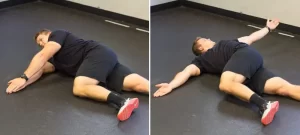
Sphinx Pose
- Lay on your stomach with your legs extended straight back.
- Lift your chest off the floor and place your forearms on the floor with your elbows beneath your shoulders.
- While keeping your shoulders relaxed, press your hips and thighs into the floor and try to stretch your spine.
- Simply adjust the height of your seat so that your lower back is properly stretched.
- Avoid overextending yourself, and stop right away if you begin to experience any pain or discomfort.
- For at least 30 seconds, hold.
- Become neutral once more.
- Then unwind.
- You should repeat this 5–10 times.
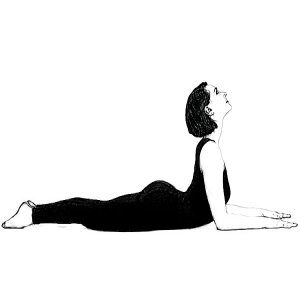
Child’s Pose
- Lie down on your mat with your feet together behind you and your knees wider than hip-width apart.
- Fold forward with your tummy resting on your thighs while you sit back on your heels (as best you can).
- Lay your head on the floor with your arms out in front of you.
- Along with your hips and glutes, your shoulders and back will also feel the stretch.
- To intensify the stretch, gently press your shoulders and chest towards the floor.
- Hold for a minute.
- Become neutral once more.
- Then unwind.
- You should repeat this 5–10 times.
Standing Rows
- Standing on your mat with your feet together behind you and your knees wider than hip-width apart.
- Standing erect and holding one handle in each hand with both arms extended straight in front of you.
- Pull both arms gently to a 90-degree bent posture.
- Keep your shoulders from shrugging at any time.
- Imagine squeezing and holding a pencil between your shoulder blades in the middle of your back while bending your elbows.
- Become neutral once more.
- Then switch sides once more.
- Then relax.
- You should repeat this 5–10 times.

Side Bending Neck Stretch
- Position your feet flat and sit up straight.
- By grabbing the edge of the chair or sitting on your hand, you can stabilize your right arm.
- Move your left ear to your left shoulder while looking straight ahead.
- You can gradually deepen the stretch by using your left hand.
- On the opposite side, repeat.
- Become neutral once more.
- Then unwind.
- You should repeat this 5–10 times.
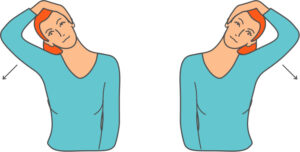
Doorway Stretch
- As suggested, when standing in an open doorway or corner, raise both arms to the side with the palms facing front and the elbows at a 90-degree angle.
- To feel the stretch in your chest and shoulders, place your hands and forearms on either side of the doorframe.
- Then, take a slow, one-footed step forward.
- Move back after holding for 20–30 seconds before releasing.
- Become neutral once more.
- Then unwind.
- You should repeat this 5–10 times.
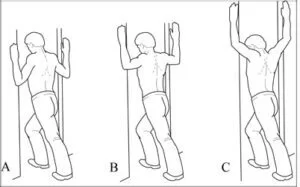
Forward neck bends (neck flexion and extension)
- Flex your chin down towards your chest.
- Feel the strain at the back of your neck as you hold the position for 5 to 10 seconds.
- Reset the balance.
- Extend your chin towards the ceiling while slowly bending your head backward.
- Feel the stretch on the front of your neck as you hold the position for 5 to 10 seconds.
- Reset the balance.
- 10 times in each direction, complete.
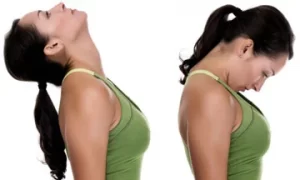
Levator scapulae stretch
- Start with a relaxing seating position on the chair.
- Bring your right hand across your head and stay there.
- Right head rotation of 45 degrees is advised.
- Slowly drop your head towards the pit of your right arm, feeling a stretch down the left side of your neck.
- After 30 seconds of holding, release.
- Then return to your neutral position.
- Continue on the left side
- Then relax.
- Repeat on each side 5-10 times.
Thoracic extension with a foam roller
- Place the foam roller at shoulder blade level perpendicular to your spine while seated on the floor.
- Use your hands to support your neck and head.
- Roll back slowly, only reaching as far over the foam roller as is comfortable for you.
- You can support your head with your hands as you slowly lengthen your neck.
- Ten times, tuck your chin, then slowly pull it back up.
- Hold your bottom touching the ground the entire time and move your upper back.
- Regain neutrality in your state.
- Then relax.
- 5–10 times should be added to this.
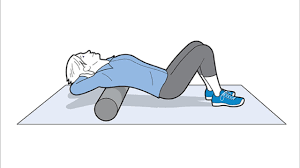
Shoulder extension
- Start with a relaxing seating position.
- At the base of your neck, clench your hands together behind your back.
- Maintain a straight back and gradually push your hands down and away from it.
- Maintain a deep breath and hold it for 20 to 30 seconds.
- Regain neutrality in your state.
- Then relax.
- 5–10 times should be added to this.
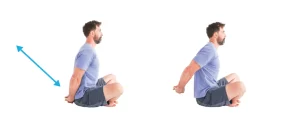
Prone Head Lifts
- By resting on your elbows while lying face down on a sturdy surface, you can lift your head, shoulders, and chest.
- Let your chin be on or very close to your chest as your head hangs completely downward.
- Make sure to retract your head (tuck your chin) before raising it to the head-neutral position.
- Attempting to look upward, keep lifting your head backward and upward as far as it will go.
- Hold that position for five seconds.
- Then gradually move through it to your original downward head-hanging position.
- Regain neutrality in your state.
- Then relax.
- That exercise should be repeated 5–10 times, twice a day.
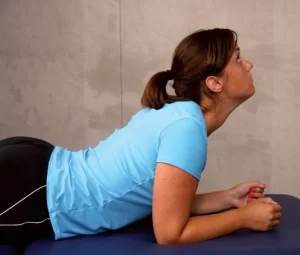
What precautions must be taken while exercising?
- Before exercising, warm up and stretch gently.
- Maintain proper posture while exercising.
- Avoid strenuous exertion.
- Stop exercising if you get unexpected pain.
- Take a break between exercises.
- Keep hydrated.
- Stretch and bend your neck slightly.
- Avoid jerky movements near the base of your neck.
Why do you not work out?
- Burning sensation in the muscles
- You are feeling ill.
- If you experience any discomfort or numbness.
- Fever and headache
- Stop exercising if it causes pain.
What sort of activities or exercises should you avoid if you have a text neck?
- Prevention is the best medicine.
- If you spend a lot of time on your computer or phone, make sure you have an appropriate sitting posture.
- Limit the amount of time you spend looking at your phone’s screen or having apps open.
- Take breaks from staring at your computer screen on a regular basis.
- You can also acquire a phone or tablet stand that angles the screen towards you, reducing the amount of time you spend looking down.
- Sit-ups put a lot of strain on your cervical spine, so avoid them.
- Crunches put too much strain on your neck, so avoid them.
FAQs
What types of activities put a strain on the neck?
An unexpected, uncomfortable movement might cause neck strain. This is common in falls, car accidents, and some sports. Working on a computer or sleeping can also create neck pain if you push your neck into a posture for an extended period of time. Muscle strains are among the reasons for neck pain. Overuse, such as spending too much time hunched over a computer or smartphone, is a common cause of strains in the muscles. Seemingly simple tasks like reading in bed can aggravate neck muscles.
Can text neck be prevented?
Move the phone (and other devices) closer to eye level to avoid having to tilt the head forward. Take regular breaks. Spend some time away from the phone—or any other form of forward-facing posture. Set an alarm or an app to remind you to take breaks from your mobile gadgets whenever necessary.
May I exercise while suffering from neck pain?
Exercise ought not to aggravate your existing neck ache. Muscle pain is common as the body adjusts to new ways of moving. This type of pain should subside soon, and your pain should be no worse the next morning after you’ve exercised.
The way can I protect my neck as I work out?
Maintaining a neutral spine and using the right muscles during a certain exercise, such as weightlifting, can help prevent neck injuries. Pause and modify your form if you feel any soreness in your neck.
Where do you get rid of neck discomfort quickly?
Stretching, moderate heat, and pain medications are typically the most effective strategies to reduce neck stiffness quickly. For chronic neck discomfort Improve your lifestyle by achieving and maintaining a healthy weight for relief and prevention. Regular exercise, including strength, flexibility, and cardiovascular workouts.
What is the duration of neck pain?
Acute neck discomfort normally subsides within one to two weeks. A few individuals recur to it after a day at work or after exerting themselves physically. Chronic neck discomfort is defined as symptoms that last more than three months.
Which is the most effective treatment for text neck?
Rest, physical therapy, stretching exercises, and modifying poor postural patterns are common treatments for text neck injury. By taking these actions, you can strengthen the muscles in your neck and upper back while also reducing the tension caused by bad posture.
At what frequency should someone suffer from text neck exercises?
Text neck pain exercises can be done daily for at least 30-35 minutes.
A simple daily exercise and stretching plan will assist you in relieving pain.
Which home exercises can you take to relieve your neck pain?
Doorway Stretch
Bow pose
Cat-Cow
Neck roll
Shoulder Scapular Squeeze
Where is the text neck most noticeable?
A neck injury caused by a protracted forward head posture is known as text neck syndrome. The curvature of the cervical spine, the muscles in the neck and shoulder, and the supporting ligaments are all impacted by the forward pending position.
When can you get rid of the neck of a texter?
occasionally arching your upper back and neck.
strengthening your back muscles with attention.
extending your neck’s range of motion.
Taking breaks from technology use.




